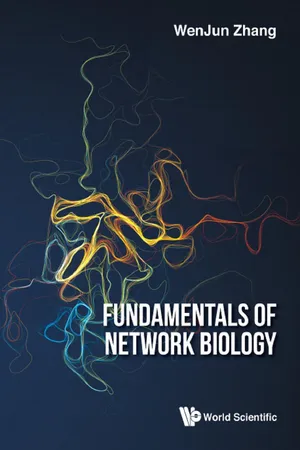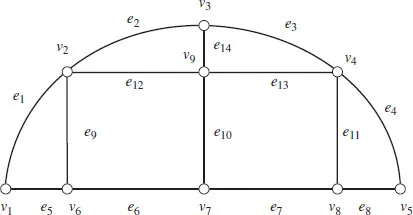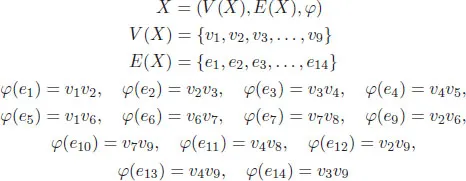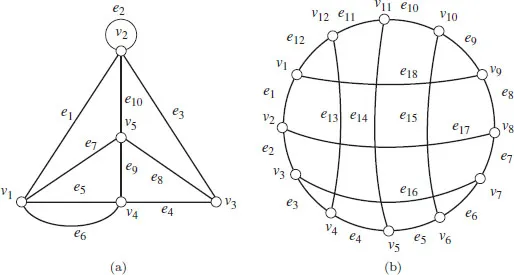
- 568 pages
- English
- ePUB (mobile friendly)
- Available on iOS & Android
Fundamentals of Network Biology
About this book
-->
As the first comprehensive title on network biology, this book covers a wide range of subjects including scientific fundamentals (graphs, networks, etc) of network biology, construction and analysis of biological networks, methods for identifying crucial nodes in biological networks, link prediction, flow analysis, network dynamics, evolution, simulation and control, ecological networks, social networks, molecular and cellular networks, network pharmacology and network toxicology, big data analytics, and more.
Across 12 parts and 26 chapters, with Matlab codes provided for most models and algorithms, this self-contained title provides an in-depth and complete insight on network biology. It is a valuable read for high-level undergraduates and postgraduates in the areas of biology, ecology, environmental sciences, medical science, computational science, applied mathematics, and social science.
--> Contents:
- Mathematical Fundamentals:
- Fundamentals of Graph Theory
- Graph Algorithms
- Fundamentals of Network Theory
- Other Fundamentals
- Crucial Nodes/Subnetworks/Modules, Network Types, and Structural Comparison:
- Identification of Crucial Nodes and Subnetworks/Modules
- Detection of Network Types
- Comparison of Network Structure
- Network Dynamics, Evolution, Simulation and Control:
- Network Dynamics
- Network Robustness and Sensitivity Analysis
- Network Control
- Network Evolution
- Cellular Automata
- Self-Organization
- Agent-based Modeling
- Flow Analysis:
- Flow/Flux Analysis
- Link and Node Prediction:
- Link Prediction: Sampling-based Methods
- Link Prediction: Structure- and Perturbation-based Methods
- Link Prediction: Node-Similarity-based Methods
- Node Prediction
- Network Construction:
- Construction of Biological Networks
- Pharmacological and Toxicological Networks:
- Network Pharmacology and Toxicology
- Ecological Networks:
- Food Webs
- Microscopic Networks:
- Molecular and Cellular Networks
- Social Networks:
- Social Network Analysis
- Software:
- Software for Network Analysis
- Big Data Analytics:
- Big Data Analytics for Network Biology
-->
--> Readership: Advanced undergraduates and graduate students and researchers in biology, ecology, pharmacology, applied mathematics, computational science, etc. -->
Keywords:Network Biology;Network Analysis;Food Webs;Molecular Networks;Social Networks;Network Pharmacology;Link Prediction;Network Dynamics;Big Data Analytics;Software;Models;Algorithms;Nodes;LinksReview:0
Frequently asked questions
- Essential is ideal for learners and professionals who enjoy exploring a wide range of subjects. Access the Essential Library with 800,000+ trusted titles and best-sellers across business, personal growth, and the humanities. Includes unlimited reading time and Standard Read Aloud voice.
- Complete: Perfect for advanced learners and researchers needing full, unrestricted access. Unlock 1.4M+ books across hundreds of subjects, including academic and specialized titles. The Complete Plan also includes advanced features like Premium Read Aloud and Research Assistant.
Please note we cannot support devices running on iOS 13 and Android 7 or earlier. Learn more about using the app.
Information










Table of contents
- Cover
- Halftitle
- Series Editors
- Title
- Copyright
- Preface
- About the Author
- Acknowledgments
- Contents
- Part 1 Mathematical Fundamentals
- Part 2 Crucial Nodes/Subnetworks/Modules, Network Types, and Structural Comparison
- Part 3 Network Dynamics, Evolution, Simulation, and Control
- Part 4 Flow Analysis
- Part 5 Link and Node Prediction
- Part 6 Network Construction
- Part 7 Pharmacological and Toxicological Networks
- Part 8 Ecological Networks
- Part 9 Microscopic Networks
- Part 10 Social Networks
- Part 11 Software
- Part 12 Big Data Analytics
- References
- Index